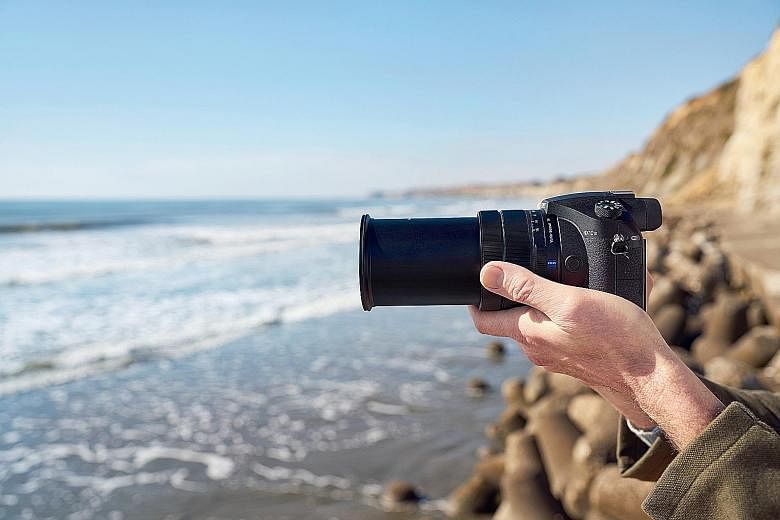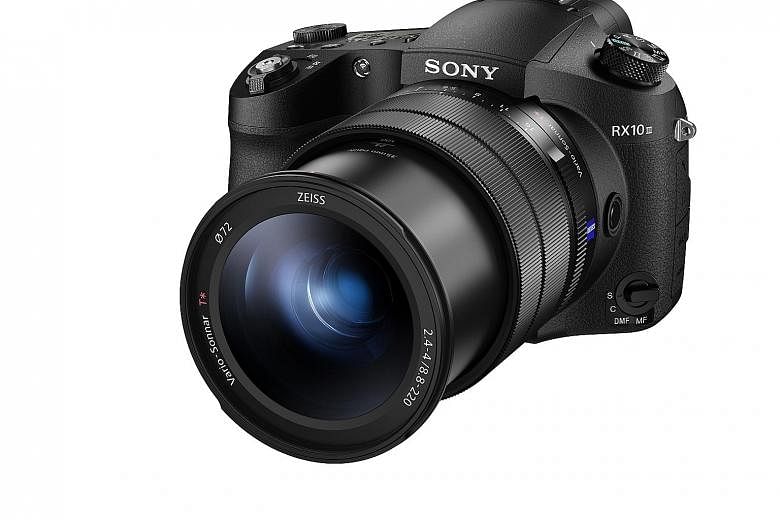Ultra-zoom compact cameras, like the new Sony Cyber-shot DSC- RX10 III, are also called bridge cameras because they bridge the gap between compact and DSLR cameras.
Most bridge cameras come with lenses that have small apertures that go no larger than f/6.5 or f/8, at the maximum focal length.
The RX10 II - predecessor of the RX10 III - is one of the few cameras that bucks the trend, with its constant, large f/2.8 aperture throughout. However, it has a maximum focal length of only 200mm when some bridge cameras can go up to 600mm.
Sony apparently heard the critics and has fitted the RX10 III with a 24-600mm lens. And it offers a large aperture of f/4 at the maximum focal length - a feat yet to be achieved by other bridge cameras.
This makes the camera ideal for shooting wildlife. But not just that, it is also a great vacation camera that lets you capture wide landscape shots and then zoom into interesting details without a fuss.
Appearance-wise, it looks exactly like its predecessor - which is a good thing. The RX10 III retains the Mark II's solid and sturdy build.
-
TECH SPECS
-
PRICE: $2,299
IMAGE SENSOR: 20.1-megapixel 1-inch CMOS
LENS: 24-600mm f/2.8-f/4
DISPLAY: Tiltable 3-inch LCD with 1.23 million dots; built-in electronic viewfinder with 2.36 million dots
SENSITIVITY: ISO 64-12,800
SHOOTING SPEED: Up to 14 frames per second
CONNECTIVITY: Wi-Fi, Near Field Communications
WEIGHT: 1,095g (with battery and memory card)
-
RATING
FEATURES: 5/5
DESIGN: 4/5
PERFORMANCE: 3/5
BATTERY LIFE: 4/5
VALUE FOR MONEY: 3/5
OVERALL: 4/5
However, due to the extra weight of the longer lens, the RX10 III's rubberised grip is now more contoured than the Mark II's for a more secure grasp of the camera .
On the downside, it is as heavy and bulky as a DSLR camera. But handling is as good as one.
All of the controls and buttons are easily accessible.
There is a mode dial on the top left with an exposure compensation dial on the top right. You can change the aperture size quickly using the aperture barrel ring, and adjust the shutter speed using the rear dial in manual mode.
Focal length is easily adjusted by using the zoom lever around the shutter release, or by turning the step zoom barrel of the lens.
It starts up in 1.5sec and shuts down in 2sec.
That's pretty fast, considering that it has an ultra-zoom lens.
Using an SD card with a writing speed of 95MB per second, the camera captured 31 RAW images in 4.4 sec before the buffer ran out.
Autofocusing (AF) is almost instantaneous in bright sunlight, when at the shorter end of the focal range. But, from 300mm onwards, getting a focus lock with AF can take up to 1sec. This is especially so for scenes without much contrast.
In dim lighting conditions and between the focal lengths of 24mm and 200mm, it takes at most 1sec to get a focus lock with the aid of the AF assist light.
From 300mm onwards, it can take around 2sec to 3sec.
Images shot with the camera exhibit sharp details with low barrel distortion throughout its long focal range. But there is some softness in images shot from 500mm and 600mm at f/4, though things look sharper at f/8.
There is no visible noise up to ISO 800. Even at ISO 1,600, there is no significant loss of details. Pictures shot at ISO 3,200 are good for small prints or Web use.
But anything above ISO 6,400 is not recommended due to much loss of details and the clearly visible chromatic noise.
The full high-definition and 4K videos that I shot with the camera were sharp. But they picked up too much wind and ambient audio.
Battery life is around 420 still images on a full charge, which is not too bad for a bridge camera.
The biggest issue with RX10 III might be the price. At $2,299, you can get a second-hand full-frame DSLR or a new mid-range APS-C DSLR camera, instead of a fixed-lens camera with a one-inch image sensor.
That said, a DSLR camera with lenses to cover the focal range of the RX10 III can easily cost tens of thousands of dollars.
•Verdict: If you are willing to pay the moolah, the Sony Cyber-shot DSC-RX10 III is a versatile and competent camera that will serve you well in your travels.



